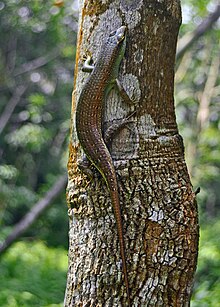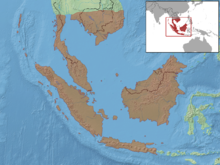| Dasia olivacea | |
|---|---|

| |
|
Scientific classification
| |
| Domain: | Eukaryota |
| Kingdom: | Animalia |
| Phylum: | Chordata |
| Class: | Reptilia |
| Order: | Squamata |
| Family: | Scincidae |
| Genus: | Dasia |
| Species: | D. olivacea
|
| Binomial name | |
| Dasia olivacea
Gray, 1839
| |

| |
| Synonyms | |
| |
Dasia olivacea, the olive dasia or olive tree skink, is a semi- arboreal species of skink lizard native to Southeast Asia.
Distribution
Dasia olivacea is found south of approximately 15° north in Southeast Asia, including parts of Laos, Malaysia, Myanmar, Thailand, Singapore, Vietnam, throughout the island of Borneo ( Sarawak, Kalimantan, Brunei), the Indonesian islands of Bali, Java and Sumatra (among others), as well as India’s Andaman and Nicobar Islands.
The species is originally known from a single locality in Cambodia. The northernmost extreme for D. olivacea is possibly the Sakaerat Environmental Research Station in the Nakhon Ratchasima Province of eastern Thailand. [2]
Ecology and conservation
Dasia olivacea lives almost exclusively in trees, only rarely descending to nest or to move between trees. [1] Eggs may be laid more than once per year, in clutches of up to 14 eggs; incubation lasts 69 days. [1] Because it is very widespread and ecologically flexible, D. olivacea is considered to be a species of Least Concern on the IUCN Red List. [1]
Taxonomy
Dasia olivacea was first described by John Edward Gray, in a publication of the Annals of Natural History (1839), [1] [3] as the type species of the (then) newly-discovered genus Dasia. The type locality was "Prince of Wales Island" (now Penang Island). [1] [3]
Description
Mature individuals of Dasia olivacea have a green back, with bronze scales towards the flanks and 12 bands of ocelli (eye-like spots) reaching from side to side. [2] [3] The head is primarily a dark olive-green colour with black markings; the underside of the head is a bluish to yellowish green. [2]
Further reading
- Greer, Allen E. (1970). "The relationships of the skinks referred to the genus Dasia". Breviora. 348: 1–30.
- Grossmann, W. (2002). "Haltung und Zucht des Braunen Baumskinks Dasia grisea (Gray, 1845) und weitere Angaben zur Nachzucht des Olivfarbenen Baumskinks Dasia olivacea Gray, 1839". Sauria. 24 (4): 35–46.
- Inger, Robert F. & Walter C. Brown (1980). "Species of the scincid genus Dasia Gray". Fieldiana Zoology. 3: 1–11. doi: 10.5962/bhl.title.3190.
References
- ^ a b c d e f Inger, R.F.; Stuart, B.L. (2010). "Dasia olivacea". IUCN Red List of Threatened Species. 2010: e.T178252A7507427. doi: 10.2305/IUCN.UK.2010-4.RLTS.T178252A7507427.en. Retrieved 20 November 2021.
- ^ a b c Peter Geissler; Duc Minh Hoang & Truong Quang Nguyen (2011). "First record of Dasia olivacea Gray, 1839 (Squamata: Scincidae) from the mainland of Vietnam" (PDF). Herpetology Notes. 4: 261–262. Archived from the original (PDF) on 2013-09-28. Retrieved 2013-09-25.
- ^ a b c John Edward Gray (1839). "Catalogue of the slender-tongued saurians, with descriptions of many new genera and species". Annals of Natural History. 2: 287–293, 331–337.
| Dasia olivacea | |
|---|---|

| |
|
Scientific classification
| |
| Domain: | Eukaryota |
| Kingdom: | Animalia |
| Phylum: | Chordata |
| Class: | Reptilia |
| Order: | Squamata |
| Family: | Scincidae |
| Genus: | Dasia |
| Species: | D. olivacea
|
| Binomial name | |
| Dasia olivacea
Gray, 1839
| |

| |
| Synonyms | |
| |
Dasia olivacea, the olive dasia or olive tree skink, is a semi- arboreal species of skink lizard native to Southeast Asia.
Distribution
Dasia olivacea is found south of approximately 15° north in Southeast Asia, including parts of Laos, Malaysia, Myanmar, Thailand, Singapore, Vietnam, throughout the island of Borneo ( Sarawak, Kalimantan, Brunei), the Indonesian islands of Bali, Java and Sumatra (among others), as well as India’s Andaman and Nicobar Islands.
The species is originally known from a single locality in Cambodia. The northernmost extreme for D. olivacea is possibly the Sakaerat Environmental Research Station in the Nakhon Ratchasima Province of eastern Thailand. [2]
Ecology and conservation
Dasia olivacea lives almost exclusively in trees, only rarely descending to nest or to move between trees. [1] Eggs may be laid more than once per year, in clutches of up to 14 eggs; incubation lasts 69 days. [1] Because it is very widespread and ecologically flexible, D. olivacea is considered to be a species of Least Concern on the IUCN Red List. [1]
Taxonomy
Dasia olivacea was first described by John Edward Gray, in a publication of the Annals of Natural History (1839), [1] [3] as the type species of the (then) newly-discovered genus Dasia. The type locality was "Prince of Wales Island" (now Penang Island). [1] [3]
Description
Mature individuals of Dasia olivacea have a green back, with bronze scales towards the flanks and 12 bands of ocelli (eye-like spots) reaching from side to side. [2] [3] The head is primarily a dark olive-green colour with black markings; the underside of the head is a bluish to yellowish green. [2]
Further reading
- Greer, Allen E. (1970). "The relationships of the skinks referred to the genus Dasia". Breviora. 348: 1–30.
- Grossmann, W. (2002). "Haltung und Zucht des Braunen Baumskinks Dasia grisea (Gray, 1845) und weitere Angaben zur Nachzucht des Olivfarbenen Baumskinks Dasia olivacea Gray, 1839". Sauria. 24 (4): 35–46.
- Inger, Robert F. & Walter C. Brown (1980). "Species of the scincid genus Dasia Gray". Fieldiana Zoology. 3: 1–11. doi: 10.5962/bhl.title.3190.
References
- ^ a b c d e f Inger, R.F.; Stuart, B.L. (2010). "Dasia olivacea". IUCN Red List of Threatened Species. 2010: e.T178252A7507427. doi: 10.2305/IUCN.UK.2010-4.RLTS.T178252A7507427.en. Retrieved 20 November 2021.
- ^ a b c Peter Geissler; Duc Minh Hoang & Truong Quang Nguyen (2011). "First record of Dasia olivacea Gray, 1839 (Squamata: Scincidae) from the mainland of Vietnam" (PDF). Herpetology Notes. 4: 261–262. Archived from the original (PDF) on 2013-09-28. Retrieved 2013-09-25.
- ^ a b c John Edward Gray (1839). "Catalogue of the slender-tongued saurians, with descriptions of many new genera and species". Annals of Natural History. 2: 287–293, 331–337.
